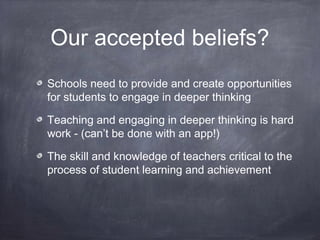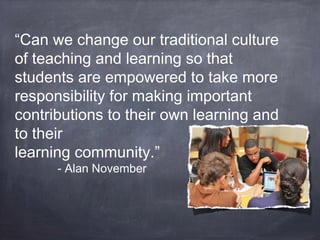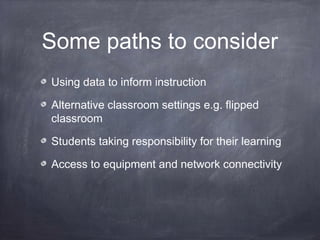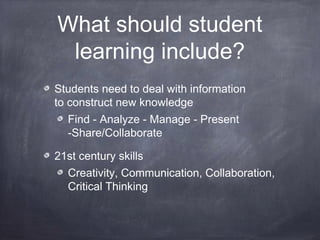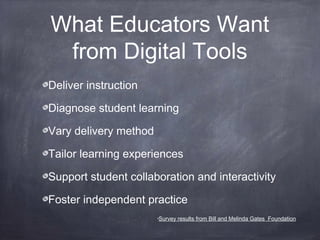Deeper thinking ccss - technology
- 1. Deeper Thinking, the Common Core and Integrating Technology to Ensure Success Chromebook Seminar
- 2. Today’s conversation Look at landscape of education today Look at what is being required/expected of students, teachers and administrators Where does technology fit in
- 3. Today’s Education Landscape Common Core curriculum and assessments APPR Shrinking budgets Research that challenges education models that were used when we were in school
- 4. Horizon Project Charts the landscape of emerging technologies for teaching, learning, and research, creative inquiry Purpose - to help educators build upon innovation taking place at their institutions by providing them with expert research and analysis - New Media Corporation
- 5. Horizon Report – Key Trends Focus of assessments shifting from “what you know” to “what you can do” Social media is changing the way people interact, present ideas and information, and communicate New emphasis in the classroom on more challenge based, active learning
- 6. Horizon Report - Challenges Faculty training does not acknowledge that digital media literacy continues its rise in importance as a key skill in every discipline and profession Innovating pedagogy is a complex process requiring research into impacts, responsive state of mind to technology changes, and understanding what strategies can make innovation in pedagogy possible K-12 must address the increased blending of formal and informal learning.
- 7. PISA Report Provides a snapshot of a nation’s performance Provides important insights into policies and practices that can inform education leaders as they refine their education systems Provide guidance to U.S. as states move to implement standards for college and career readiness
- 8. PISA Questions Test whether students can apply their knowledge to real-world problems and to “analyze, reason and communicate effectively as they pose, interpret, and solve problems in a variety of situations.”
- 9. PISA Findings Nations with top performers have clear expectations for student learning that include emphasis on using knowledge to solve real-world problems ensure that teachers are deep learners, and can lead classrooms where students think critically, solve problems, and communicate effectively
- 11. Gray School Principal meets daily for one period with one grade level - occasionally does formal observations, rest of the day in her office Knows some students by name Purchased $350,000+ of technology equipment based solely on input from vendors Teachers vocalize that expectations are not clear - procedures change very often, with little or no warning
- 12. Red School Principal meets daily for one period with one grade level - rest of the day spent doing informal observations, formal observations, has lunch in her office with students Knows just about every student by name, greets students and teachers everyday at front entrance Has concrete, clear, well-articulated expectations of students and teachers
- 13. School Environment 4 computer carts housed in a “Staff development” classroom -hardly if ever used Smartboards in every room - more than half not used at all Computer lab - students go once a week use drill and practice software Two classroom computers used for word processing and drill and practice Google Apps for Education school 4 computer carts in use continually - teachers decide among themselves when used Smartboards in every room - used continually No computer lab Two classroom computers used for word processing Google Apps for Education school
- 14. It’s not about technology it’s about learning and teaching
- 15. Our accepted beliefs? Schools need to provide and create opportunities for students to engage in deeper thinking Teaching and engaging in deeper thinking is hard work - (can’t be done with an app!) The skill and knowledge of teachers critical to the process of student learning and achievement
- 16. “Can we change our traditional culture of teaching and learning so that students are empowered to take more responsibility for making important contributions to their own learning and to their learning community.” - Alan November
- 17. Not one path to change Culture and environment of each school/district is unique It needs to be considered and honored Important to plan and strategize Develop action and plan and implement Less is more - although plan can envision many changes implement one or two at a time Include constituents in planning
- 18. Teachers need to be deeper thinkers too! Need to engage in deeper thinking activities Need to see what deeper thinking lessons and activities look like Need professional development Need to be supported in taking risks to try new approaches show some video clips from Ed Leader 21 youtube
- 19. Some paths to consider Using data to inform instruction Alternative classroom settings e.g. flipped classroom Students taking responsibility for their learning Access to equipment and network connectivity
- 20. What should student learning include? Students need to deal with information to construct new knowledge Find - Analyze - Manage - Present -Share/Collaborate 21st century skills Creativity, Communication, Collaboration, Critical Thinking
- 21. Important to think about how you can and want to use technology
- 22. Technology in the Common Core http://commoncore.fcoe.org/sites/commoncore.fcoe.org/files/resources/SPIRAL%20FINAL.pdf
- 23. Google Can Be a Support Tool Find - Google Search and Google Scholar Analyze - Google spreadsheets and forms Manage - Google Drive organizing files social bookmarking sites (not Google!) concept mapping software (not Google!) Present - Google presentations Share / Collaborate - Google Suite
- 24. Using Google Docs in the Classroom
- 25. Google Drive Enables Students to Access their work from any computer, anywhere, with an Internet connection Create and submit work electronically to teachers Work collaboratively peer editing collaborative projects Organize and analyze data Collect information
- 26. Google Drive Enables Teachers/Admins to Access their work from any computer, anywhere, with an Internet connection Teachers can create and submit content to students teachers comment directly on student work Provide student feedback and extra-help Work collaboratively curriculum writing data analysis, and more! Collect information from various constituencies
- 27. Role of Administrators Model what we believe in Provide an environment of communication and collaboration Support (reasonable!) risk taking eSchool News Article - 5 Qualities of a Tech Savvy Administrator Role of Leaders in 21st Century Education
- 28. What does this look like in your school? Access to technology Professional development Is it available? Are you evaluating its effectiveness? Technology plan Do you have one? Are you using it? Do your constituents know about it?
- 29. “The world as we have created it is a process of our thinking. It cannot be changed without changing our thinking.” - Albert Einstein
- 30. Questions ???
- 31. For info on this presentation and resources cited http://tinyurl.com/custom-june-2014
- 32. Example of Deeper Thinking Student Activity “Tools not as important as the connections made possible by them”
- 33. Hallmarks of Connected Classroom 1.Reliable broadband and Wi-Fi internet access 2.One-to-one and/or bring-your-own-device 3.Teachers who give up control 4.Students and teachers learn together 5.Administrative support 6.Communication and collaboration between IT and curriculum leaders •eSchool News article
- 34. What Educators Want from Digital Tools Deliver instruction Diagnose student learning Vary delivery method Tailor learning experiences Support student collaboration and interactivity Foster independent practice •Survey results from Bill and Melinda Gates Foundation
- 35. College and Career Ready Students Demonstrate independence Build strong content knowledge Respond to varying demands of audience, task, purpose, discipline Comprehend and critique Value evidence Use technology strategically and capably Come to understand other perspectives and cultures http://coretaskproject.com/2013/04/12/wagners-21st-century-learning-skills-and-the-ccss/
- 36. Collective Intelligence • “How can people and computers be connected–so that collectively–they act more intelligently than individuals, groups, or computers have ever done before?” MIT Center for Collective Intelligence
Editor's Notes
- Don’t get heebie-jeebies! I was a math major because I shied away from lots of theoretical stuff!
- Highlight two recent reports First is the Horizon report issued by the New Media Corporation
- Twitter Facebook access to global intelligence social bookmarking
- launch in 1997, become a leading reference on the quality of education systems worldwide. Tests given every three years, assesses the knowledge and competencies of 15-year-olds in three subjects: reading, mathematics and science. To date, about 70 countries have taken part in the assessment, comparing results and learning from one another in PISA’s collaborative global network. The next round of results (PISA 2012) will be published on 3 December 2013 and preparations for the following round (PISA 2015) are already underway. Some important features of PISA: • The age of the students surveyed – 15 years – is an age at which an assessment of career- and college-readiness is particularly important. • PISA assesses cumulative learning from early childhood through primary and secondary schooling. • It addresses both cognitive and non-cognitive learning outcomes, including students’ strategies for and attitudes towards learning. • It examines not only how well students reproduce knowledge, but also whether they can apply knowledge in diverse practical settings within and outside of school.
- ONE POLICY THE NATIONS WITH TOP PERFORMERS APPEAR TO SHARE IS CLEAR EXPECTATIONS FOR STUDENT LEARNING THAT INCLUDE AN EMPHASIS ON THE ABILITY TO USE KNOWLEDGE TO SOLVE REAL-WORLD PROBLEMS. COUNTRIES WITH TOP PERFORMERS ALSO ENSURE THAT TEACHERS ARE DEEP LEARNERS THEMSELVES AND ARE CAPABLE OF LEADING CLASSROOMS IN WHICH STUDENTS THINK CRITICALLY, SOLVE PROBLEMS, AND COMMUNICATE EFFECTIVELY.
- Both principals cared about the students and wanted to provide the best program possible
- Mention the monthly newsletter
- talk about how the schools use Google communications -mail collect and analyze data eportfolios Red School every student has account, all communication done through gmail and shared docs No electronic communication - no use of Google apps
- Alan November is recognized internationally as a leader in education technology. He began his career as an oceanography teacher and dorm counselor at an island reform school for boys in Boston Harbor. He has been a director of an alternative high school, computer coordinator, technology consultant, and university lecturer. As practitioner, designer, and author, Alan has guided schools, government organizations and industry leaders as they plan to improve quality with technology.
- Need to observe each other teach to see and understand good and bad teaching
- Students take responsibility for their learning - move from chalk and talk to include project-based work
- Talk about use of email sending memos electronically
- Begin with 2 quotes that I hope will anchor and guide this presentation while challenging our vision and of education today














